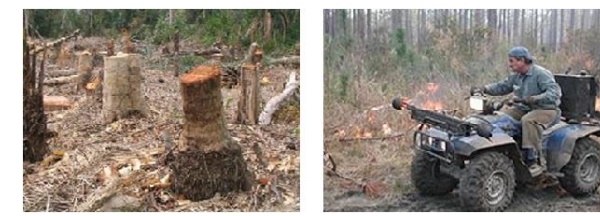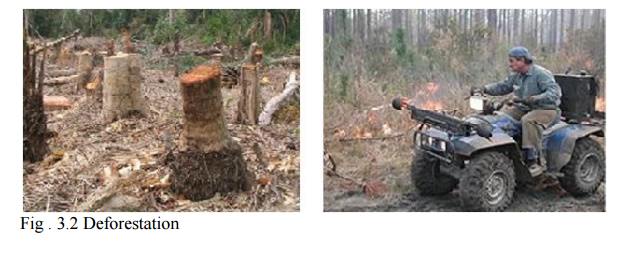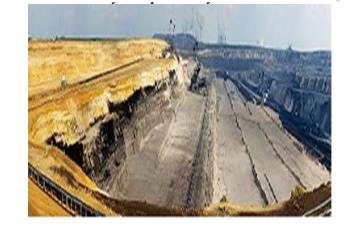Chapter: Environmental Science and Engineering
Deforestation

Deforestation
Deforestation
means destruction of forests.
The total
forests area of the world in 1900 was estimated to be 7,000 million hectares
which was reduced to 2890 million ha in 1975 fell down to just 2,300 million ha
by 2000.
Deforestation
rate is relatively less in temperature countries, but it is very alarming in
tropical countries.
Deforestation
is a continuous process in India where about 3.3 hectares of forest land has
been lost. The per capita availability of forest in India is 0.08 hectares per
person which is much lower than the world average of 0.8 hectares.
The
presence of waste land is a sign of deforestation in India.
1 Causes of Deforestation
Major
causes of deforestation are listed below:
Development
projects
Shifting
cultivation
Fuel
requirements cutting and burning
Construction
of dams
Growing
food needs.

1.1 Consequences of deforestation
Some of
the effects of deforestation are listed below:
a) Effect on climate
Global
warming Less rainfall Hot climate.
b) Effect on biodiversity
Loss of
medicinal plants. Loss of timber, fuel wood.
c)
Effect on
resources
Loss of
land resource Loss of soil fertility Soil erosion
Drastic
changes in biogeochemical cycles
d) Effect on economy
Increase
in medicinal values Demand of industrial products. e) Effect on food
Loss of
fruit production Loss of root based foods.
Case Studies
Desertification
in hilly regions of the Himalayas:
Desertification
in Himalayas, involving clearance of natural forests and plantation of
monocultures like Pinus roxburghi, Eucalyptus camadulensis etc., have upset the
ecosystem by changing various soil and biological properties.
The area
is invaded by exotic weeds. These areas are not able to recover and are losing
their fertility.
Case Studies
![]()
Following
the destruction of forest rain fall declined in Chhota Nagpur to such an extent
that tea-gardens also disappeared from the region.
Waning rain fall in Udhagamandalam
The
rainfall pattern was found to fluctuate with wooded land area in the hills.
When the Nilgiri mountains had luxuriant forest cover annual rainfall used to
be much higher.
TIMBER EXTRACTION
Logging
for valuable timber such as teak and mahogany not only involves a few large
trees per hectare but about a dozen more trees since they are strongly
interlocked with each other by vines etc.
Also road
construction for making approach to the trees causes further damage to the
forests.
In India,
firewood demand would continue to rise in future mostly consumed in rural
areas, where alternative sources of energy, are yet to reach.

MINING
Mining is
the process of removing deposits of ores from substantially very well below the
ground level.
Mining is
carried out to remove several minerals including coal.
These
mineral deposits invariably found in the forest region, and any operation of
mining will naturally affect the forests.
Mining
from shallow deposits is done by surface mining while that from deep deposits
is done by sub-surface mining.
More than
80,000 ha of land of the country are presently under the stress of mining
activities.

1 Effects of mining resources
Mining
operation require removal of vegetation along with underlying soil mantle and
overlying rock masses. This results in destruction of landscape in the area.
Large
scale of deforestation has been reported in Mussorie and Dehradun valley due to
mining of various areas.
Indiscriminate
mining in Goa since 1961 has destroyed more than 50,000 ha of forest land.
Mining of radioactive mineral in Kerala, Tamilnadu and Karnataka are posing
similar threats of deforestation.
DAMS AND THEIR EFFECTS ON FORESTS AND TRIBAL PEOPLE
Big dams
and river valley projects have multi-purpose uses and have been referred to as
"Temples of modern India”.
India has
more than 1550 large dams, the maximum being in the state of Maharashtra (more
than 600) followed by Gujarat (more than 250) and Madhya Pradesh (130).
The
highest one is Tehri dam, on river Bhagirathi in Uttaranchal and the largest in
terms of capacity is Bhakra dam on river Sutlej.
Fig 3.6 Dams

1 Effects on Tribal people
The
greatest social cost of big dam is the widespread displacement of local people.
It is
estimated that the number of people affected directly or indirectly by all big
irrigation projects in India over the past 50 years can be as high as 20
millions.
The
Hirakud dam, one of the largest dams executed in fifties, has displaced more
than 20,000 people residing in 250 villages.
2 Effects on forests
Thousands
of hectares of forests have been cleared for executing river valley projects
which breaks the natural ecological balance of the region. Floods, landslides
become more prevalent in such areas.
Eg:
The
Narmada sagar project alone has submerged 3.5 lakh hectares of best forest
comprising of rich teak and bamboo forests.
The Tehri
dam submerged 1000 hectares of forest affecting about 430 species of plants
according to the survey carried out by the botanical survey of India.
Related Topics